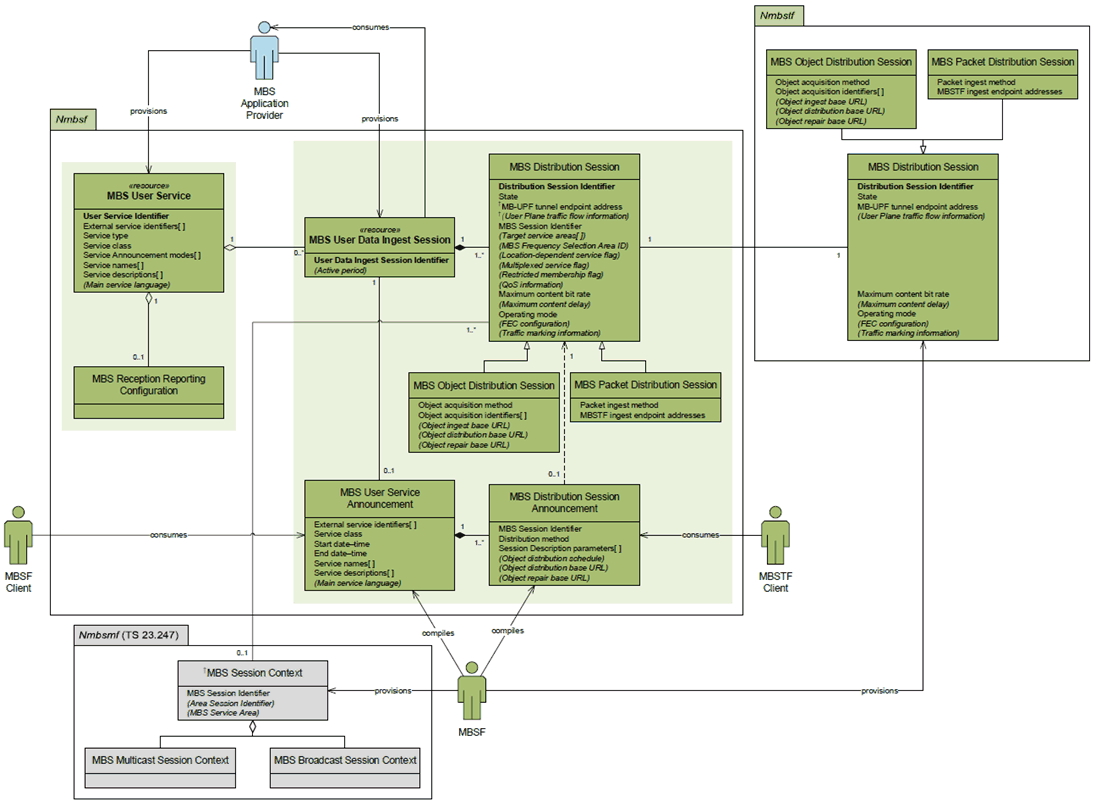Content for TS 26.502 Word version: 17.3.0
4.5.2 Static information model p. 19
Figure 4.5.2-1 shows how the different service and session concepts depicted in Figure 4.5.1-1 above relate to each other. In this Figure:
1)
Shortly before the current time enters the time window of a provisioned MBS User Data Ingest Session:
The MBS Application Provider provisions the parameters of a new MBS User Service by invoking the Nmbsf service either directly, or via the NEF. This specifies which of the Service announcement modes are to be used to advertise the MBS User Service, as well as descriptive metadata for inclusion in the MBS User Service Announcement.
2)
The MBS Application Provider provisions a number of time-bound MBS User Data Ingest Sessions within the scope of the MBS User Service by invoking the Nmbsf service either directly, or via an equivalent Nnef service provided by the NEF. Each MBS User Data Ingest Session includes the details of one or more MBS Distribution Sessions.
3)
- To indicate that it has a restricted MBS service area (i.e. corresponding to a local MBS Service, as defined in clause 6.2.2 of TS 23.247), an MBS Distribution Session may specify one or more Target service areas. In line with [5], MBS data is not transmitted outside the MBS service area derived from the indicated Target service areas.
- To provision location-dependent variants of an MBS User Service (see clause 6.2.3 of TS 23.247), a number of MBS Distribution Sessions conveying different MBS data may be provisioned within the scope of the same MBS User Service by setting the Location-dependent service flag on the MBS Distribution Sessions of each variant. Location-dependent MBS Distribution Session variants shall have the same MBS Session Identifier, but they shall have disjoint Target service areas.
- When the Multiplexed service flag is set on the MBS Distribution Session, all MBS Distribution Sessions with an identical (or empty) set of Target service areas shall be multiplexed onto the same MBS Session. The MBS Session Identifier shall be the same for all MBS Distribution Sessions within the multiplex. This feature may be combined with the Location-dependent service flag, in which case each location-dependent multiplex of MBS Distribution Sessions is mapped into a separate MBS Session.
The MBS Application Provider may additionally provision an MBS Consumption Reporting Configuration within the scope of the MBS User Service by invoking the Nmbsf service either directly, or via the NEF.
4)
The MBSF provisions an MBS Session in the MBS System by invoking the Nmbsmf service on the MB-SMF (see clause 9 of TS 23.247) to allocate a TMGI (if one has not already been allocated) for each MBS Distribution Session and to create an MBS Session Context for each one. The parameters of the MBS Session Context shall be populated as specified in clause 4.5.9. In response, the MB-SMF provides the MB-UPF ingest information (specifically, the MB-UPF tunnel endpoint address and traffic flow information to be used by the MBSTF) to the MBSF.
5)
The MBSF provisions an MBS Distribution Session in the MBSTF by invoking the Nmbstf service at reference point Nmb2 using the parameters from the newly created MBS Session Context.
6)
Using the parameters from the MBS Distribution Session and from the newly created MBS Session Context, the MBSF compiles an MBS User Service Announcement to advertise the availability of the MBS User Service and makes this service access information available by one or more of the Service announcement modes provisioned in the MBS User Service.
